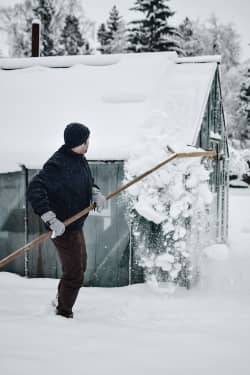5 Easy Ways to Winter-Proof Your Home
Anyone who lives in northern latitudes knows that much of their time is going to be spent contending with snow, sleet, and ice, especially during the Winter months. However, not everyone takes steps to ensure that their home is protected from the elements when the Winter chill strikes. Here are some easy tips for anyone who needs to Winter-proof their home for the Winter.
1- Keep Your Pipes Nice and Cozy
Pipes are just like humans. When the thermometer dips below freezing, they like nothing better than to be wrapped up snugly in a soft lining of insulation. With us, it might be a fleece jacket, woolen blanket, and a roaring fire. With plumbing, you can easily source high-quality insulation to prevent the nightmare of a burst water pipe.
Be careful about the kind of insulation you use. Foam-based materials can be flammable, so many professionals tend to recommend fiberglass or natural fiber-based insulation mixes. Fiberglass also tends to be a little cheaper.
You should also make sure that cold air struggles to gain access to your cavity walls. Block up any gaps in your outer wall such as entry points for TV cables or washing machine outlets. Seal them up with a little caulking for extra pipe protection. It also makes sense to let a little warm air into your wall cavities via cupboards if possible, and be sure to keep the heating on if you go away.
2- Secure Your Roof Before the Ice and Snow Arrive
 One of the major forms of Winter home damage is lost roof shingles. As snow and ice move around, they can easily cause shingles to become unstable, resulting in troublesome roof damage. It's not much fun repairing a roof in Winter either, so taking steps beforehand to nail down shingles firmly makes great sense.
One of the major forms of Winter home damage is lost roof shingles. As snow and ice move around, they can easily cause shingles to become unstable, resulting in troublesome roof damage. It's not much fun repairing a roof in Winter either, so taking steps beforehand to nail down shingles firmly makes great sense.
Carry out a full roof check before the snow arrives. Can you spot any shingles that are lifting or damaged? These are weak spots that Winter will mercilessly exploit, so have them replaced or fixed if you can. Also, check that there is no roof mortar missing and that all gutters are clear and stable. The extra weight of snow and water can easily bring them down, so be prepared.
A good tip for double-checking that your roof is secured is to climb up into your attic and turn the lights off. It might be spooky up there, but you can spot unprotected roof sections by looking for sunlight filtering through!
3- Stay Warm by Planning Ahead
Nobody wants their central heating to fail in the depths of Winter. Instead of having to wear all of your sweaters under a mountain of duvets every night, ensure that all heating pipes are guarded against freezing. One way to do this is by using specialist antifreeze compounds. Instead of having to keep your heating on constantly during the colder months, antifreeze products can keep the system working and protect against other pests such as limescale and corrosion.
If you love to have an open fire burning, make sure that you provide plenty of ventilation so that the smoke your fire generates doesn't damage your walls and paintwork. Keep your chimney clean as well, to minimize the risk of chimney fires that are caused by soot build-up.
4- Don't Forget About Flooding
One of the nasty things about snow and ice is that they love to melt, posing a seasonal flood risk to your home. If you allow snow to melt into your basement or ground floor, this can cause permanent water damage, so it's a good idea to act fast whenever a snowfall occurs.
Shovel snow away from your basement and plan ahead so that when the snow comes, it tends to drain away from the home and unblock any drains while the weather is mild. For extra peace of mind, it might also be a good idea to lift any valuables away from the basement floor, even if only for the Winter months.
If you haven't already done so, it's a good idea to swap conventional air vents for a flood-resistant variety, and you might also want to install door guards to keep out water as the snow thaws.
5- Take Sensible Steps to Protect Your Home
Stock up on salt, keep trees trimmed, and be proactive when the weather turns chilly so that any risks can be met head-on. However, the real key to Winter home protection is planning ahead.
Use the Fall and early Winter to clear out gutters, remove leaf litter from your yard, clear a drainage route for melting snow, insulate your pipes, and weather-proof your roof. The results will be worth it when your neighbors are racking up bills to fix their Winter worries.
With the right preparation, anyone can protect their home and family from the Winter weather, allowing them to enjoy the colder months.